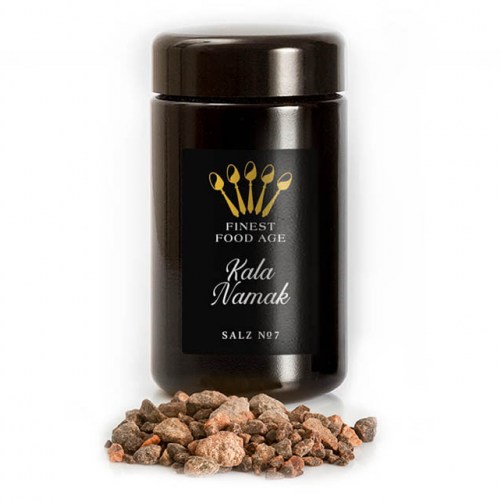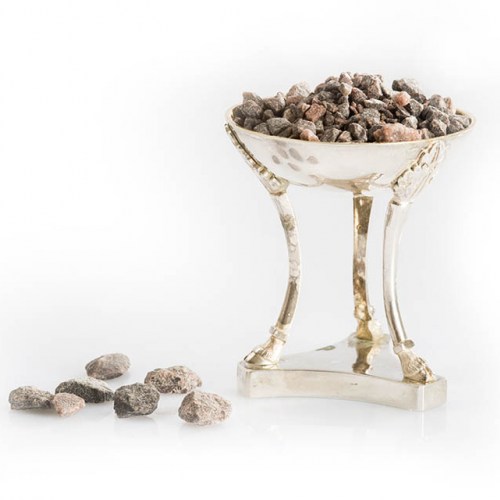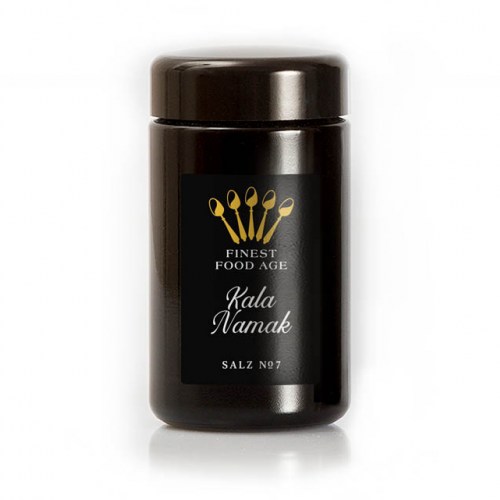




 Add to cart
Add to cart
Kala namak salt is a highly unusual salt that is produced by an old ayurvedic method. Natural salt crystals are crushed, then placed in heavy clay jars along with some haritaki and amla (fruits often used in Indian traditional medicine) and cooked for several hours. This special method of preparation causes the nutritious components of the fruit to bind with the salt to form reddish-black crystals with a characteristic sulphurous smell.
The kala namak salt in the finestfoodage SALT COLLECTION is quite unique! Just looking at it reveals that this Indian salt speciality is something out of the ordinary: it has a distinctive reddish-black colour and its coarse-grained structure gives it a gravelly appearance.
Its flavour is even more unusual: because kala namak salt is high in hydrogen sulphide, it tastes remarkably like boiled egg.
Put a bit of kala namak salt on your tongue and you might think you were biting into a boiled egg with a little salt on it …
Kala namak salt is best added after cooking. Only a small amount is needed to achieve the desired taste. The kala namak salt in the finestfoodage SALT COLLECTION is coarse-grained and is therefore perfect for your salt mill.
The salt’s unmistakeable character with its distinctive smoky note makes it particularly suitable for Asian dishes. In Indian cooking kala namak salt is used mainly in dhal, chutneys and yoghurt-based raitas.
It is exquisite on raw tomato and cucumber. It complements most vegetables, exotic fish dishes and fried rice or noodle dishes. Because the taste of kala namak salt is reminiscent of egg, it goes well with mayonnaise and garlic sauces.
In India even sweet dishes such as fruit salads are traditionally seasoned with kala namak salt. A pinch of the salt on exotic fruit is an unusual culinary treat! In the same way, kala namak salt adds an extravagant touch to fruit juices and long drinks.
In ayurvedic teaching on health, the fruits used to make kala namak – haritaki (also known as harad) and amla (also called amalaki) – are “superfoods”; they are basic ingredients of various revitalising recipes.
In Tibetan medicine haritaki is called the “king of medicines”; it has many beneficial properties and is considered to be an aphrodisiac. Amla is described in the ayurvedic texts as “the fruit of eternal youth and beauty”.
By the way: kala namak was investigated by the German Federal Institute for Risk Assessment (BfR) in 2003 and officially classed as “not harmful to health”. So there is no need to worry about its relatively high concentration of hydrogen sulphide.
To ensure protection from harmful environmental influences, the kala namak salt in the finestfoodage SALT COLLECTION is supplied in high-quality violet glass jars. Keeping this special jar tightly closed will ensure that the kala namak salt always has the dry and dark Storage conditions that it needs.
Salt should not be kept next to the stove or over the cooker hood because the cooking carried out in this area produces a lot of moisture that will quickly cause the salt to become clumpy.